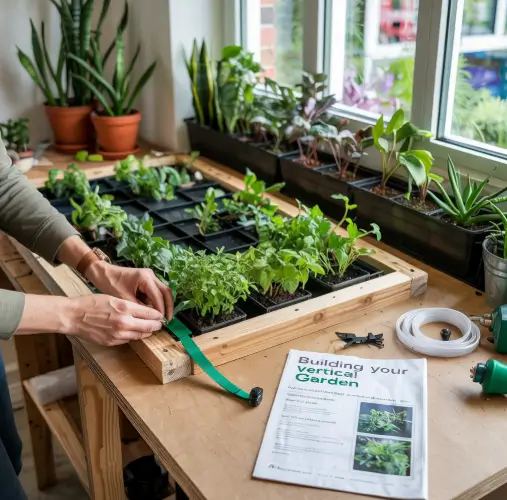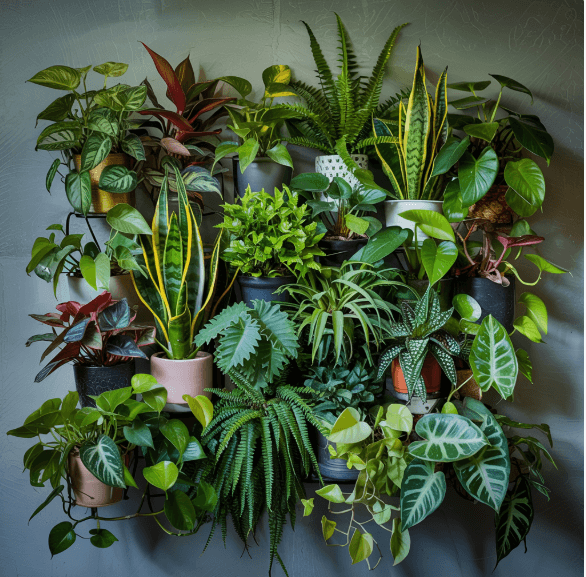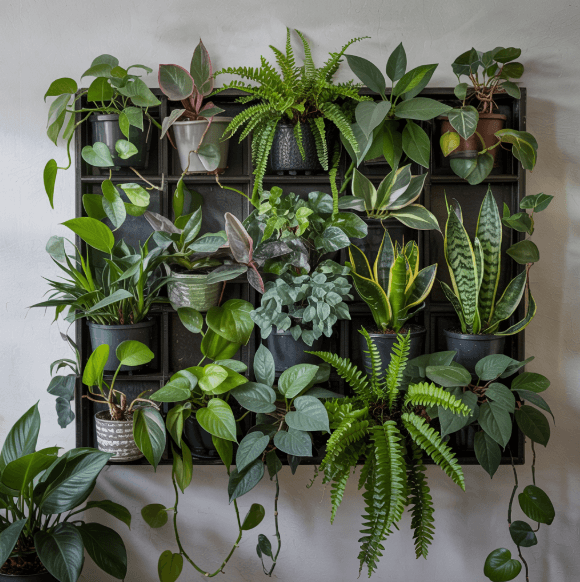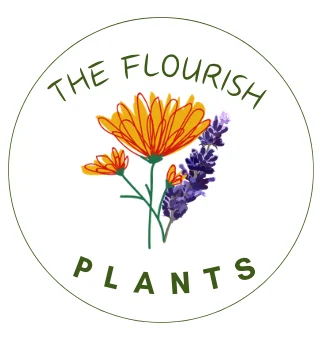Have you ever walked into a room with a living wall and felt instantly refreshed? There’s something magical about seeing plants growing vertically, transforming ordinary walls into vibrant, living art. The good news? You can create this natural wonder in your home with a DIY indoor green wall.
Table of Contents
Understanding DIY Indoor Green Walls
A DIY indoor green wall is a vertical garden you create yourself, where plants grow on a wall rather than in traditional pots on horizontal surfaces. Unlike outdoor versions, indoor green walls are designed specifically for interior environments, with considerations for lighting, moisture management, and plant selection.
The concept dates back to the ancient Hanging Gardens of Babylon, but was modernized in the 1980s by French botanist Patrick Blanc. Today’s green walls range from simple hanging pot arrangements to sophisticated systems with built-in irrigation.
These living installations offer remarkable benefits:
- Improved air quality through natural filtration
- Enhanced mood and reduced stress
- Natural sound absorption for quieter spaces
- Space efficiency by growing upward instead of outward
- Temperature and humidity regulation
- A unique conversation starter for your home

Planning Your DIY Indoor Green Wall Project
Assessing Your Space and Light Conditions
Evaluate the natural light your potential wall receives throughout the day. Most indoor plants require at least some light to thrive, though many low-light tolerant options exist. Consider temperature stability (ideally 65-80°F) and avoid walls near heating vents, air conditioners, or frequently opened doors.
Determining Budget and Scale
A small green wall using recycled materials might cost $100-200, while larger systems with built-in irrigation could run $500-1,000. Measure your wall space carefully, considering both the area you want to cover and the depth your system will extend into the room (typically 6-12 inches).
Selecting the Right Wall Location
The ideal wall should be:
- Easily visible from primary seating areas
- Accessible for regular maintenance
- Free from obstructions that might be damaged by moisture
- Structurally sound enough to support the weight
Consider unexpected locations like kitchens for herb gardens or bathrooms, where humidity benefits many plants.
Understanding Weight and Structural Considerations
A fully saturated green wall system can weigh 10-20 pounds per square foot. For drywall installations, anchor into wall studs. For renters, consider freestanding systems that lean against the wall. Always plan for waterproof backing and a catch basin for excess water.
Essential Materials for Construction
Framework Materials
- Wooden Frames: Inexpensive and visually appealing. Use cedar or redwood sealed with non-toxic waterproof sealant.
- Metal Frames: More durable but expensive. Aluminum is lightweight and corrosion-resistant.
- PVC Frameworks: Lightweight, waterproof, and budget-friendly.
- Pre-made Panel Systems: Simplest option with integrated planting pockets.
Plant Container Systems
- Pocket Systems: Lightweight fabric pockets create individual planting spaces.
- Modular Plastic Containers: Durable interlocking containers that create a grid.
- Tray Systems: Horizontal trays stacked vertically for larger plants.
- Repurposed Containers: Bottles, cans, or gutters for budget-conscious gardeners.
Irrigation Options
- Drip Irrigation: Controlled water delivery directly to plant roots.
- Reservoir Systems: Water containers at the top that gradually release moisture.
- Recirculating Systems: Collect and reuse water for efficiency.
- Manual Watering: Feasible for small installations only.
Budget-Friendly Alternatives
Transform wooden pallets, fabric shoe organizers, vinyl gutters, or plastic bottles into creative planting systems with proper preparation and drainage.
Step-by-Step Construction Guide
Creating the Backing Structure
- Cut exterior-grade plywood to size
- Apply 2-3 coats of waterproof sealant
- Add a decorative frame if desired
- Pre-drill mounting holes aligned with wall studs
Installing the Moisture Barrier
- Attach heavy-duty plastic sheeting to the back of your structure
- Seal all edges completely
- Plan for drainage management
Setting Up the Framework
- Mount the backing to the wall using appropriate anchors
- Install horizontal or vertical supports for your containers
- Test stability before adding plants
Mounting Plant Containers
- Attach your chosen container system securely
- Ensure proper drainage for each planting space
- Arrange containers for easy maintenance access
Implementing the Irrigation System
- Position the water reservoir or main water line
- Connect distribution tubes to each planting section
- Test the system before adding plants

Best Plants for Your Indoor Green Wall
Low-Maintenance Options
- Pothos: Thrives in various light conditions with beautiful trailing vines
- Snake Plant: Nearly indestructible with striking upright leaves
- ZZ Plant: Survives weeks without watering
- Spider Plant: Non-toxic to pets and excellent air purifiers
- Philodendron: Available in climbing, trailing, and upright varieties
Design Principles
- Create focal points with distinctive plants at eye level
- Combine upright and trailing varieties for dimension
- Allow space for growth between initial plantings
- Arrange plants in odd numbers to enhance visual interest.
- Arrange plants to guide the viewer’s eye across the wall
Light Requirements
Match plants to your wall’s light conditions:
- Bright direct light: Succulents, crotons, some flowering plants
- Bright indirect light: Ferns, peperomias, prayer plants
- Low light: Pothos varieties, ZZ plants, peace lilies
Consider supplemental grow lights for walls with insufficient natural light.

Maintaining Your Green Wall
Watering and Fertilizing
Start with more frequent watering as plants establish, then adjust based on your specific plants and environment. Use diluted liquid fertilizer during growing seasons (spring through early fall) and reduce or eliminate during winter.
Pruning and Replacing Plants
Regularly trim plants to maintain shape and prevent overcrowding. Remove yellowing leaves promptly. Plan to replace approximately 10-20% of plants annually as they outgrow their space or decline.
Pest Management
Inspect regularly for common pests like spider mites, mealybugs, and fungus gnats. Try natural remedies first: insecticidal soap, neem oil, or diatomaceous earth. Healthy plants resist pests better, so maintain proper watering, light, and nutrition.
Creative Design Ideas
- Minimalist: Use monochromatic plantings or grid patterns for contemporary spaces
- Tropical: Create lush density with bold foliage and cascading elements
- Geometric: Arrange plants in chevron, ombré, or diagonal patterns
- Functional: Incorporate herbs and edible plants in kitchen walls
- Small-Space Solutions: Try door-mounted systems, window frames, or corner installations
Troubleshooting Common Issues
- Water problems: Adjust irrigation, check for clogs, ensure proper drainage
- Plant health: Address yellowing leaves (often overwatering) or leggy growth (insufficient light)
- Structural issues: Reinforce sagging sections or loose containers promptly
- Mold prevention: Improve air circulation and avoid wetting foliage
Cost Analysis and Benefits
A 4×4 foot DIY wall typically costs $300-800 compared to $1,000-3,000 for professional installation. Ongoing expenses include minimal water usage, possible electricity for pumps or lights, and annual plant replacements.
The benefits extend beyond aesthetics to include improved air quality, natural humidity regulation, sound dampening, and potential energy savings through insulation. Many homeowners report enhanced well-being and productivity in spaces with living walls.
Frequently Asked Questions About DIY Indoor Green Walls
Based on the most common questions people ask about creating and maintaining indoor green walls, here are answers to help you on your vertical gardening journey:
How much does it cost to build a DIY indoor green wall?
The cost varies significantly based on size, materials, and plant selection. A small DIY green wall (approximately 3×3 feet) using budget-friendly materials might cost $100-200, while larger or more sophisticated systems with built-in irrigation could run $500-1,000. This compares favorably to professionally installed living walls that typically start at $1,000 for the same size and can easily reach $3,000 or more.
How do I prevent mold and mildew on my indoor green wall?
Mold prevention requires good air circulation, proper watering techniques, and regular maintenance:
- Install a small fan near your wall if the air seems stagnant
- Water in the morning to allow moisture to evaporate throughout the day
- Avoid wetting foliage when watering
- Maintain proper spacing between plants to allow airflow
- For small outbreaks on the growing medium, sprinkle ground cinnamon (a natural fungicide) or spray with diluted hydrogen peroxide solution
What are the best plants for an indoor green wall?
Low-maintenance plants that thrive in vertical systems include:
- Pothos (various varieties)
- Snake plants
- ZZ plants
- Spider plants
- Philodendrons
- Peace lilies
- Ferns (Boston, bird’s nest)
- Peperomias
- Air plants (Tillandsia)
- Small succulents (for walls with bright light)
Match your plant selection to your wall’s specific light conditions for best results.
How frequently should I water my indoor living wall?
Watering frequency depends on your specific plants, environmental conditions, and system design. Generally:
- New installations need more frequent watering (every 2-3 days) as plants establish themselves
- Established walls typically need watering 1-2 times per week
- Walls in air-conditioned or heated spaces may need more frequent watering
- Use a moisture meter to objectively assess when watering is needed rather than following a rigid schedule
- Automated irrigation systems can be set on timers, but still require regular monitoring and seasonal adjustments
Can I build an indoor green wall if I’m renting?
Absolutely! Renter-friendly options include:
- Freestanding green walls mounted on casters that don’t attach to the actual wall
- Tension rod systems that don’t require drilling
- Over-the-door hanging pocket systems
- Magnetic planting systems for metal surfaces
- Modular units that sit on furniture or shelving
- Lightweight felt pocket systems with minimal mounting points
Always check with your landlord first and consider waterproof backing to protect floors and walls.
How much light does an indoor green wall need?
Light requirements depend entirely on your plant selection:
- Most common houseplants need at least moderate indirect light
- Low-light plants like pothos, ZZ plants, and snake plants can thrive in dimmer conditions
- For walls with insufficient natural light, LED grow lights provide an excellent solution
- South-facing walls (in the Northern Hemisphere) receive the most light, while north-facing walls receive the least
- Light meters (including smartphone apps) can help you objectively measure your space’s light levels
Will an indoor green wall damage my wall?
With proper installation, your green wall shouldn’t damage your home:
- Always use a waterproof barrier between your living wall and the building wall
- Ensure proper drainage to prevent water accumulation
- Mount securely into studs or use appropriate anchors for the wall type
- Consider a catch basin at the bottom to collect excess water
- Regularly check for any signs of moisture issues and address them immediately
How much maintenance does an indoor green wall require?
Expect to spend:
- 15-30 minutes weekly for watering (if manual)
- 30-60 minutes monthly for pruning, checking for pests, and general maintenance
- 2-3 hours quarterly for more thorough maintenance, including fertilizing and possibly replacing some plants
- More time initially as you learn your wall’s specific needs, less as you establish a routine
Can I grow herbs and edible plants on an indoor green wall?
Yes! Many herbs and some compact vegetables thrive in vertical systems:
- Culinary herbs like basil, mint, oregano, thyme, and chives are excellent choices
- Leafy greens such as lettuce and spinach can work well with adequate light
- Strawberries adapt well to vertical growing
- Microgreens require minimal soil depth and grow quickly
- Position edible plants where they’re easily accessible for harvesting
- Consider using a separate irrigation zone, as edibles often have different water requirements than ornamentals
How do I prevent pests on my indoor green wall?
Preventive measures and early intervention are key:
- Inspect new plants thoroughly before adding them to your wall
- Check your wall regularly for signs of pests
- Maintain appropriate watering and light conditions, as stressed plants are more susceptible
- For minor infestations, try insecticidal soap, neem oil, or diatomaceous earth
- Isolate and treat affected sections immediately to prevent spread
- Introduce beneficial insects like ladybugs for natural pest control in larger installations

Success Stories
From kitchen herb havens to office productivity boosters, DIY enthusiasts have transformed blank walls, awkward corners, and unused spaces into thriving vertical gardens. The most successful projects start small, invest in quality components, and plan realistically for maintenance.
Whether you’re looking to improve air quality, create a stunning focal point, or simply bring more nature indoors, a DIY indoor green wall offers a rewarding project with lasting benefits. With proper planning and care, your living wall will continue to evolve and enhance your space for years to come.
As a simple project, it could evolve into a transformative element in your home and life, so for more information about Green walls indoors, check this article.
What story will you add to this growing community of green wall enthusiasts?
